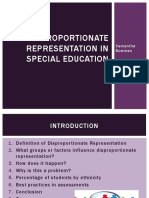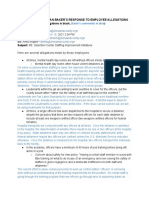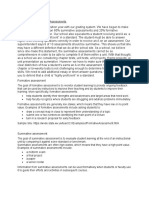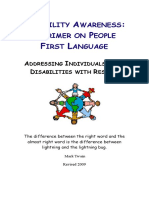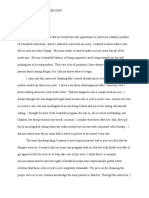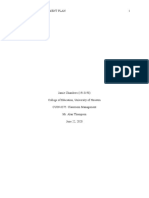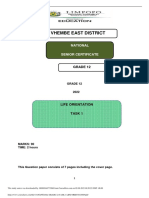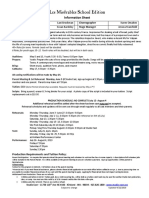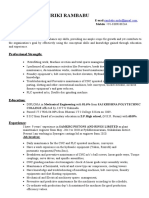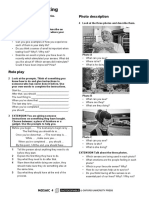Oral Language
Oral Language
Uploaded by
vangelibCopyright:
Available Formats
Oral Language
Oral Language
Uploaded by
vangelibOriginal Description:
Copyright
Available Formats
Share this document
Did you find this document useful?
Is this content inappropriate?
Copyright:
Available Formats
Oral Language
Oral Language
Uploaded by
vangelibCopyright:
Available Formats
Brittanie Vangeli Oral Language Assessment March 5,2013 Since the ability to communicate orally is relevant to many tasks
that are performed in school and outside of the school, it is important that the student masters this skill. The purpose of this oral language assessment is to assess how the student is communicating in the classroom. The development of language is critical for students to establish strong literacy skills. This assessment will show how well the student can effectively communicate. This assessment will also determine if the student can share stories, retell events, explain how to do something, create an imaginative world, can plan events, and take leadership etc. While oral assessment is the most commonly used form of assessment, the assessor must ensure that there is a methodology for using this assessment tool. For this assessment I will be using the forms Oral Language Function: Classroom Observation and Oral Language Functions: Individual Observation. This assessment is an observation assessment of both the classroom and the individual student. The Classroom Observation form can be used in two different ways. The first being as a checklist to ensure that certain functions occur in the classroom. For example, that there is time set-aside for students to share stories with the class or a partner. Second this form could also be used as a tool to record the progress of a student or a group of students who may need more support. The Individual Observation form on the other hand is used to record your observations of an individual student. This form will help the teacher assess where the individual
strengths and weakness are with regard to oral language. This form can also be used to communicate with parents on how the student is performing. I am currently participating in a second grade classroom at Wicoff Elementary. My student is a friendly, active second grader. She is polite, respectful and shows a willingness to do her work. However, she has been struggling in the classroom. I have observed that she is shy and has trouble taking the lead. For example, Ms. Refsin is currently engaging the students with problem solving activities and it is clear through my observation that she is lacking the skills to solve these problems. Compared to the other students in her class, she appears to be behind in mastering the skills that the other students are having no problem becoming proficient in. In a science lesson they were making a ramp for a marble to roll down. The students were arranged in groups of two and had to figure out how to create the ramp. My student just sat to the side and played around with the marble while the other student was actively engaged in the activity. It should be also noted that this student is currently in the process of being tested for a learning disability. Through my observation I am confident that these test will reveal that she has some type of learning disability that is holding her back from reaching her full academic potential. If possible, I think that a personal aid for this student would be ideal. I observed in writers workshop that she has to be worked with one on one. If not worked with one on one, then she often times achieves nothing during the writing time and falls behind. She constantly needs someone with her so she can keep up with the other second graders. In addition, I also think that this student is better
taught in a smaller group. From my observations I have noticed that she works better in a smaller group or one on one because she can get more of the teachers attention. In writers workshop she is two workshop stories behind the other students. It will also be helpful for her to work at a slower pace because now she is using recess time to catch up. In my opinion, I do think that this student will be much better off in a resource room. I believe that if she was tested and classified then the resource room will accommodate her needs much better. She will be able to have more time on projects and work at a slower speed. Most importantly, she can have that one on one instruction she needs. All in all, I have learned a lot about this student through this assessment. Through this assessment I was able to figure out the childs needs and weaknesses. I was able to evaluate what the child needs in the future.
You might also like
- Psych FinalDocument6 pagesPsych Finalapi-245810041100% (1)
- Case Studies Accommodations2Document4 pagesCase Studies Accommodations2api-325828984No ratings yet
- Essay 1Document6 pagesEssay 1api-237394235No ratings yet
- Disproportionate Representation in Special EducationDocument11 pagesDisproportionate Representation in Special Educationapi-369895400No ratings yet
- The Effects of High-Stake TestingDocument16 pagesThe Effects of High-Stake Testingapi-290450773No ratings yet
- Student Observation ReportDocument5 pagesStudent Observation Reportapi-423859884No ratings yet
- English Only VsDocument4 pagesEnglish Only Vsapi-475025036100% (1)
- Adding of Polynomials For CanvasDocument13 pagesAdding of Polynomials For Canvasadrianrandolf baysicNo ratings yet
- 20 Attention SignalsDocument9 pages20 Attention SignalsMariam AliasNo ratings yet
- Chelsea Kupersmit Professor Stephanie Niemis MAT 596: Final Portfolio RubricDocument41 pagesChelsea Kupersmit Professor Stephanie Niemis MAT 596: Final Portfolio Rubricapi-301541155No ratings yet
- What Is SociolinguisticDocument6 pagesWhat Is SociolinguisticNur Hasina Mohd IbrahimNo ratings yet
- Through Deaf EyesDocument2 pagesThrough Deaf Eyesapi-507835274No ratings yet
- Translanguaging in Reading Instruction 1Document8 pagesTranslanguaging in Reading Instruction 1api-534439517No ratings yet
- 10 Ways To Help Ells Succeed in MathDocument3 pages10 Ways To Help Ells Succeed in Mathapi-259726587No ratings yet
- Teacher Behavioral Strategies A MenuDocument6 pagesTeacher Behavioral Strategies A Menuapi-309686430No ratings yet
- Engaging Students in The Global ClassroomDocument13 pagesEngaging Students in The Global ClassroomJessa RosalesNo ratings yet
- Powerpoint Bilingual Education Vs English ImmersionDocument15 pagesPowerpoint Bilingual Education Vs English Immersionapi-308813640No ratings yet
- Jail Director Bryan Baker's Response To Officer AllegationsDocument2 pagesJail Director Bryan Baker's Response To Officer AllegationsKatie BieriNo ratings yet
- ReflectionDocument8 pagesReflectionapi-241188643No ratings yet
- Ratio Lesson PlanDocument3 pagesRatio Lesson Planapi-254497624No ratings yet
- MLSS Supplemental Guide For Student Assistance Team 2019Document16 pagesMLSS Supplemental Guide For Student Assistance Team 2019Ann CannonNo ratings yet
- Case Study - Atypical StudentDocument5 pagesCase Study - Atypical Studentapi-283127505No ratings yet
- Positive Relationships Can Also Help A Student Develop SociallyDocument8 pagesPositive Relationships Can Also Help A Student Develop SociallyHaironisaMalaoMacagaanNo ratings yet
- Stephen Krashen's Theory of Second Language AcquisitionDocument5 pagesStephen Krashen's Theory of Second Language AcquisitionAdolfo Limon CapacetaNo ratings yet
- Qualitative and Quantitative Evaluation ResearchDocument3 pagesQualitative and Quantitative Evaluation Researchkitai123No ratings yet
- Teaching Strategies Essay Marisol 8Document9 pagesTeaching Strategies Essay Marisol 8Marisol LealNo ratings yet
- Synthesis EssayDocument5 pagesSynthesis Essayapi-431078653No ratings yet
- High Incidence DisabilitiesDocument6 pagesHigh Incidence DisabilitiesAshlynCagleNo ratings yet
- How Children and Adults Learn Languages EssayDocument3 pagesHow Children and Adults Learn Languages EssayVeronica EscabillasNo ratings yet
- Esl Teaching ReflectionDocument3 pagesEsl Teaching Reflectionapi-456438584No ratings yet
- Chapter 10 Grouping StudentsDocument14 pagesChapter 10 Grouping StudentsKhaztandi IbrahimNo ratings yet
- Siop Lesson FinalDocument10 pagesSiop Lesson Finalapi-214081578No ratings yet
- Learning Vocabulary Through GamesDocument15 pagesLearning Vocabulary Through GamesDiago SofranoNo ratings yet
- Specifying Purpose Statement and Research QuestionsDocument21 pagesSpecifying Purpose Statement and Research QuestionsMuhammad Ainur RizqiNo ratings yet
- The Benefits of Heterogeneous Groupings Over Homogeneous GroupingsDocument20 pagesThe Benefits of Heterogeneous Groupings Over Homogeneous GroupingsKimberly CarterNo ratings yet
- Formative Vs SummativeDocument1 pageFormative Vs Summativeapi-333352303No ratings yet
- Faf People FirstDocument16 pagesFaf People Firstapi-402505140No ratings yet
- Standardized Testing Research PaperDocument9 pagesStandardized Testing Research Paperapi-254568926No ratings yet
- Learning Theory (Social Constructivism) ELTDocument7 pagesLearning Theory (Social Constructivism) ELTAnne ZakariaNo ratings yet
- Parent InterviewDocument5 pagesParent Interviewapi-534568579No ratings yet
- Pacheco Signatureassignment Ble407Document24 pagesPacheco Signatureassignment Ble407api-293667101No ratings yet
- Unit Block - Lesson PlanDocument3 pagesUnit Block - Lesson Planapi-297260967No ratings yet
- Stakeholders in The Iep Process JDocument9 pagesStakeholders in The Iep Process Japi-546526887No ratings yet
- Classroom Management PlanDocument11 pagesClassroom Management Planapi-519098681No ratings yet
- Chapter 4 GeometryDocument30 pagesChapter 4 Geometrydarlene bianzonNo ratings yet
- Budgeting ActivitiesDocument2 pagesBudgeting Activitiesapi-288395661No ratings yet
- Siop Math Lesson PlanDocument8 pagesSiop Math Lesson Planapi-374164490No ratings yet
- Diversity EssayDocument12 pagesDiversity Essayapi-351304277No ratings yet
- Handout 2 Case StudiesDocument5 pagesHandout 2 Case StudiesKumutha ShiniNo ratings yet
- UDL Case Studies PacketDocument3 pagesUDL Case Studies PacketAcid_Bath76100% (2)
- Precis - Reaching Teaching TraumaDocument3 pagesPrecis - Reaching Teaching TraumaRay Still0% (1)
- Specifying A Purpose and Research Questions or HypothesisDocument9 pagesSpecifying A Purpose and Research Questions or Hypothesisapi-545326560100% (1)
- Lesson Plan 2 Like TermsDocument8 pagesLesson Plan 2 Like Termsapi-245950665No ratings yet
- Midterm ReflectionDocument3 pagesMidterm Reflectionapi-302766006No ratings yet
- What Makes An Effective TeacherDocument3 pagesWhat Makes An Effective TeacherRia Lucena100% (1)
- Parent and Family Involvement Plan 1Document29 pagesParent and Family Involvement Plan 1api-248637452No ratings yet
- Overview of ConstructDocument2 pagesOverview of Construct200941990No ratings yet
- Literacy Lesson Plan First DraftDocument5 pagesLiteracy Lesson Plan First DraftMelina VarneyNo ratings yet
- Kounin and Classroom ManagementDocument5 pagesKounin and Classroom Managementsarboukhk100% (1)
- I TEACH MY HEART OUT EVERY DAY: What More Do You Want From Me?From EverandI TEACH MY HEART OUT EVERY DAY: What More Do You Want From Me?No ratings yet
- ResumeDocument1 pageResumevangelibNo ratings yet
- Literacy PhilosophyDocument2 pagesLiteracy PhilosophyvangelibNo ratings yet
- Letter 2013Document1 pageLetter 2013vangelibNo ratings yet
- Plant Unit PlanDocument20 pagesPlant Unit Planvangelib0% (1)
- Letter To TeacherDocument1 pageLetter To TeachervangelibNo ratings yet
- The Ultimate Montessori Gift Guide For Children Ages 0 To 12 Years OldDocument40 pagesThe Ultimate Montessori Gift Guide For Children Ages 0 To 12 Years OldJenifer NishaNo ratings yet
- Courtney Rae Ricks ResumeDocument3 pagesCourtney Rae Ricks Resumeapi-647371301No ratings yet
- DLP-Grade 9 HealthDocument2 pagesDLP-Grade 9 Healthisabelle ramosNo ratings yet
- PDF Solution Manual To Digital Systems Principles andDocument2 pagesPDF Solution Manual To Digital Systems Principles andGabriel Hamashia100% (1)
- STM32 F105 XX STM32 F107 XXDocument104 pagesSTM32 F105 XX STM32 F107 XXbehbehbehNo ratings yet
- En - 0717 6996 Arq 103 90Document14 pagesEn - 0717 6996 Arq 103 90.No ratings yet
- Henry L - Tischler Introduction To Sociology, 10th Edition Wadsworth Publishing (2010) (1) 40 46Document7 pagesHenry L - Tischler Introduction To Sociology, 10th Edition Wadsworth Publishing (2010) (1) 40 46abiybillaevvakamilaNo ratings yet
- Lean 4.0 Webinar SlidesDocument23 pagesLean 4.0 Webinar SlidesPeash MredhaNo ratings yet
- Acms 2017Document3 pagesAcms 2017sweta yadavNo ratings yet
- Daily Lesson Log: Pre-CalculusDocument46 pagesDaily Lesson Log: Pre-CalculusLeah Mae France100% (2)
- 2022 Grade 12 Task 1 Life Orientation PDFDocument8 pages2022 Grade 12 Task 1 Life Orientation PDFJowaNo ratings yet
- Book Review - 360 Leader Noor ZakiyahDocument5 pagesBook Review - 360 Leader Noor ZakiyahJohn AlvarezNo ratings yet
- Product Development PlaybookDocument15 pagesProduct Development Playbookkundaichitungo23No ratings yet
- Les-Assignment BoysoupDocument19 pagesLes-Assignment Boysoupapi-302463139No ratings yet
- Dennis A. Mugot, PH.D: Individual Performance Commitment and ReviewDocument4 pagesDennis A. Mugot, PH.D: Individual Performance Commitment and ReviewAnnemargarettejustine CruzNo ratings yet
- The Top 10 Reasons Maintenance Planning Is Not EffectiveDocument8 pagesThe Top 10 Reasons Maintenance Planning Is Not EffectiveWisnu DriyaskoroNo ratings yet
- Physics Chemistry Biology Biology: Candidate's NameDocument62 pagesPhysics Chemistry Biology Biology: Candidate's NameKrishnendu BeraNo ratings yet
- Sci6 Q1 Mod4 TechniquesInSeparatingMixtures v5Document20 pagesSci6 Q1 Mod4 TechniquesInSeparatingMixtures v5billchile77No ratings yet
- Coalition College Curriculum ReportDocument1 pageCoalition College Curriculum ReportJake HawkesNo ratings yet
- ISL Tajuk 5 Listening SkillsDocument2 pagesISL Tajuk 5 Listening SkillsgmailNo ratings yet
- Suraya Binti Sharip Matric No: 825970: Question 1: Stancy Lee Case StudyDocument4 pagesSuraya Binti Sharip Matric No: 825970: Question 1: Stancy Lee Case StudySuraya Binti SharipNo ratings yet
- Communicative English-IIDocument170 pagesCommunicative English-IIAdedokun Opeyemi SodiqNo ratings yet
- Les Misérables School Edition: Information SheetDocument2 pagesLes Misérables School Edition: Information SheetNiskaNo ratings yet
- Rambabu ResumeDocument2 pagesRambabu Resumesekhar bodasingiNo ratings yet
- MOV Per Indicator For Highly Proficient Teachers For RPMS SY 2020-2021Document4 pagesMOV Per Indicator For Highly Proficient Teachers For RPMS SY 2020-2021Maricar Magallanes100% (1)
- Mosaic TRD4 Tests U8 SpeakingDocument1 pageMosaic TRD4 Tests U8 SpeakingDaniela Osuna100% (1)
- 03 Inglés - What Is Your Favorite Musical InstrumentDocument1 page03 Inglés - What Is Your Favorite Musical InstrumentEstefanía AlfaroNo ratings yet
- Architecture YearbookDocument66 pagesArchitecture YearbookPetra Yonathan100% (2)
- Brainy Kl5 Unit Test 7 BDocument2 pagesBrainy Kl5 Unit Test 7 BAleksandra Wzorek100% (3)
- Zen Judo HandbookDocument0 pagesZen Judo HandbookEmilio Raschia100% (1)



